| |
|
|
| |
|
|
| |
Wakayama
Castle |
| |
|
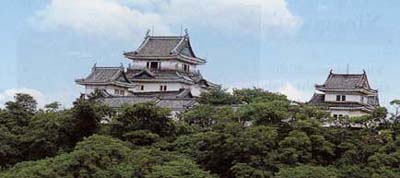
|
| |
|
In your wanderings, you will encounter the capital of Wakayama Prefecture,
Wakayama City, at the source of the Kinokawa River. The city dates its origins
to 1585, when Toyotomi Hideyoshi had the castle built. Today, Wakayama City
is the cultural and economic hub of a prefecture whose geographic location
is ideal - situated at the northern end of the breathtaking Kii Peninsula
and at the mouth of the Seto Naikai Inland Sea. You can reach Kansai International
Airport in 30 minutes, Osaka by train in an hour, and both of the ancient
cities of Nara and Kyoto within two hours. |
| |
|
Historic Wakayama Castle
It was Toyotomi Hideyoshi's brother Hidenaga who undertook
the Wakayama Castle construction in 1585, but he never saw the completed
fortress because he left the city. The first long-term occupant of the
castle was Kuwayama Shigeharu, Hideyoshi's retainer, who arrived bringing
with him 30,000 goku of rice (one goku is the equivalent of how much rice
a person consumes over a year). During his 14-year residency, Shigeharu
fortified the castle as the compound's centerpiece.
Switching loyalties from Hideyoshi to Tokugawa Ieyasu after the latter's
victory at the Battle of Sekigahara in 1600, Asano Yoshinaga became the
new lord of the castle, bringing with him 376,000 goku of rice and developing
the castle grounds, especially Ichinohashi Bridge, over his nearly 20-year
residence.
Yoshinaga left Wakayama in 1619 and the prolific shogun Ieyasu sent Yorinobu
(his 10th son!) to the castle with 555,000 goku of rice, and under Yorinobu's
leadership and financial support Wakayama became the Tokugawa shogunate's
key western fortress, expanding into the surrounding castle town and becoming
the stable foundation of two and a half centuries of prosperity in Wakayama
City.
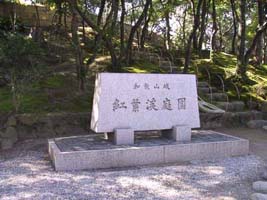 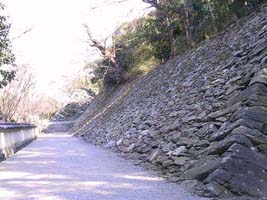
|
| |
|
| Honmaru
Castle location: At the peak of Mt. Torafusu, the tiger-shaped
mountain.
Castle plan:
Eastern peak area - Living quarters
Western peak area - Castle tower complex. In the complex are the
main tower, small tower, kitchen, turrets and gates, which form
a secure rectangle when the Kusunoki Gate is closed.
Ninomaru: Main residence of the daimyo during the Tokugawa Era
The donjon was almost destroyed in 1846 by lightning. Although
the daimyo did not normally allow any construction work on the castle
exterior, once the Tokugawa clan head took up residence there, he
consented to the walls being repaired in 1850.
The castle suffered tremendous damage from fire bombings in 1945
and after the war Wakayama citizens collected financial donations
from private and public sources to rebuild their cherished city
symbol. Made of ferro-concrete, the reconstruction was finished
in 1958. |
| |
| Ninomaru
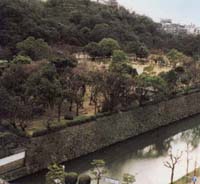 This
was the daimyo's main residence and base of operations. The inner
palace was separated into three sections and three turrets connected
by a mud retaining wall enclosed the area. This
was the daimyo's main residence and base of operations. The inner
palace was separated into three sections and three turrets connected
by a mud retaining wall enclosed the area.
|
| |
| Otemon Gate
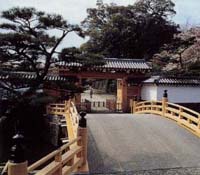 The
Ichinohashi Gate, built at the order of Toyotomi Hideyoshi, was
the castle's main entryway and was renamed Otemon by the Tokogawa
feudal lord in 1796. This impressive gate (along with the Ichinohashi
Bridge) was rebuilt in 1983, long after its collapse in 1909. The
Ichinohashi Gate, built at the order of Toyotomi Hideyoshi, was
the castle's main entryway and was renamed Otemon by the Tokogawa
feudal lord in 1796. This impressive gate (along with the Ichinohashi
Bridge) was rebuilt in 1983, long after its collapse in 1909. |
| |
| Okaguchimon Gate
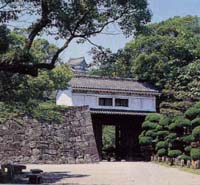 The
Okaguchimon still stands in its original form. The castle's back
entrance was constructed by Tokugawa Yorinobu and was designated
an Important Cultural Property in 1957. The
Okaguchimon still stands in its original form. The castle's back
entrance was constructed by Tokugawa Yorinobu and was designated
an Important Cultural Property in 1957.
|
|
| |
|
|
| |
|
|
| |
|
|
| |
Waka-no-Ura |
| |
|
 Recognized
by Emperor Shomu in 724, the beauty of this location earned it a place in
the Manyoshu Collection as a place of exquisite beauty. Recognized
by Emperor Shomu in 724, the beauty of this location earned it a place in
the Manyoshu Collection as a place of exquisite beauty.
|
| |
|
|
| |
Wakayama Marina City |
| |
|
 This
area includes "Porto Europa", a theme park with a multicultural flavor,
"Wakayama-kan" offers visitors a chance to experience Wakayama's vast
natural environment, and fresh seafood can be had at the "Kuroshio Market".
For more fun, try your luck at fishing sea bream and yellowtail. Fish
all you want and then you can enjoy your catch right there on the premises,
or have the cooks do your fish up for you to take home with you. And for
the pleasure of young and old, men and women, why not take a dip in the
"Kishu Kuroshio Hot Springs"? This
area includes "Porto Europa", a theme park with a multicultural flavor,
"Wakayama-kan" offers visitors a chance to experience Wakayama's vast
natural environment, and fresh seafood can be had at the "Kuroshio Market".
For more fun, try your luck at fishing sea bream and yellowtail. Fish
all you want and then you can enjoy your catch right there on the premises,
or have the cooks do your fish up for you to take home with you. And for
the pleasure of young and old, men and women, why not take a dip in the
"Kishu Kuroshio Hot Springs"?
Wakayama Marina City Tel: 073-448-0011 |
| |
|
Porto Europa
The buildings of this theme park can be divided into three classifications:
Spanish old castles, Italian fishery ports, and traditional French
streets. The park has much to offer including attractions, rides,
restaurants and events. |
|
|
| |
|
|
| |
Kuroshio Market |
| |
|
| The market is divided into the market, sales and eatery
zones. The variety of fresh seafood available is plentiful, including
everything from that flown in from all over the world through Kansai
International Airport to that taken from around Wakayama. Groceries
and special products from Wakayama are also for sale here. Visitors
can cook their newly-bought produce and meats at the barbeque pits
located on the grounds. Also, don't miss the cutting of the 100-kilogram
tunas. |
 |
 |
|
| |
|
|
| |
Kishu Kuroshio Hot Springs |
| |
|
 Natural
hot springs that emerged from a stratum formed some 100 million years ago
and at an ocean depth of 1,500 meters are used here. This hot springs facility
has an expansive main bath, outdoor hot spring and sauna. Natural
hot springs that emerged from a stratum formed some 100 million years ago
and at an ocean depth of 1,500 meters are used here. This hot springs facility
has an expansive main bath, outdoor hot spring and sauna. |
| |
|
|
| Wakayama Visitors' Promotion Office Tel: 073-435-1234 |
|
| |
|
|
| |
|
|
 Recognized
by Emperor Shomu in 724, the beauty of this location earned it a place in
the Manyoshu Collection as a place of exquisite beauty.
Recognized
by Emperor Shomu in 724, the beauty of this location earned it a place in
the Manyoshu Collection as a place of exquisite beauty. Natural
hot springs that emerged from a stratum formed some 100 million years ago
and at an ocean depth of 1,500 meters are used here. This hot springs facility
has an expansive main bath, outdoor hot spring and sauna.
Natural
hot springs that emerged from a stratum formed some 100 million years ago
and at an ocean depth of 1,500 meters are used here. This hot springs facility
has an expansive main bath, outdoor hot spring and sauna. 




 This
was the daimyo's main residence and base of operations. The inner
palace was separated into three sections and three turrets connected
by a mud retaining wall enclosed the area.
This
was the daimyo's main residence and base of operations. The inner
palace was separated into three sections and three turrets connected
by a mud retaining wall enclosed the area.  The
Ichinohashi Gate, built at the order of Toyotomi Hideyoshi, was
the castle's main entryway and was renamed Otemon by the Tokogawa
feudal lord in 1796. This impressive gate (along with the Ichinohashi
Bridge) was rebuilt in 1983, long after its collapse in 1909.
The
Ichinohashi Gate, built at the order of Toyotomi Hideyoshi, was
the castle's main entryway and was renamed Otemon by the Tokogawa
feudal lord in 1796. This impressive gate (along with the Ichinohashi
Bridge) was rebuilt in 1983, long after its collapse in 1909.  The
Okaguchimon still stands in its original form. The castle's back
entrance was constructed by Tokugawa Yorinobu and was designated
an Important Cultural Property in 1957.
The
Okaguchimon still stands in its original form. The castle's back
entrance was constructed by Tokugawa Yorinobu and was designated
an Important Cultural Property in 1957.  This
area includes "Porto Europa", a theme park with a multicultural flavor,
"Wakayama-kan" offers visitors a chance to experience Wakayama's vast
natural environment, and fresh seafood can be had at the "Kuroshio Market".
For more fun, try your luck at fishing sea bream and yellowtail. Fish
all you want and then you can enjoy your catch right there on the premises,
or have the cooks do your fish up for you to take home with you. And for
the pleasure of young and old, men and women, why not take a dip in the
"Kishu Kuroshio Hot Springs"?
This
area includes "Porto Europa", a theme park with a multicultural flavor,
"Wakayama-kan" offers visitors a chance to experience Wakayama's vast
natural environment, and fresh seafood can be had at the "Kuroshio Market".
For more fun, try your luck at fishing sea bream and yellowtail. Fish
all you want and then you can enjoy your catch right there on the premises,
or have the cooks do your fish up for you to take home with you. And for
the pleasure of young and old, men and women, why not take a dip in the
"Kishu Kuroshio Hot Springs"?


